Analyzing Starbucks' Customer Loyalty and Branding Strategies Report
VerifiedAdded on 2020/10/22
|7
|2398
|395
Report
AI Summary
This report provides an in-depth analysis of Starbucks' customer loyalty strategies and their impact on profitability. It examines how Starbucks has cultivated a strong brand image and a loyal customer base through various initiatives, including its reward programs, mobile application, and emphasis on customer experience. The report highlights the application of the Pareto Principle, demonstrating how a significant portion of Starbucks' revenue is generated by a smaller percentage of loyal customers. It also discusses the importance of personalization, community building, and the integration of technology in enhancing customer engagement and retention. The report references academic journals and studies to support its findings, providing a comprehensive overview of Starbucks' success in the competitive coffee market. Furthermore, the report emphasizes the role of mobile applications in streamlining the ordering process, along with offering personalized experiences to foster a sense of belonging and encourage repeat purchases. The conclusion emphasizes the effectiveness of customer loyalty in achieving higher profitability and competitive advantage.
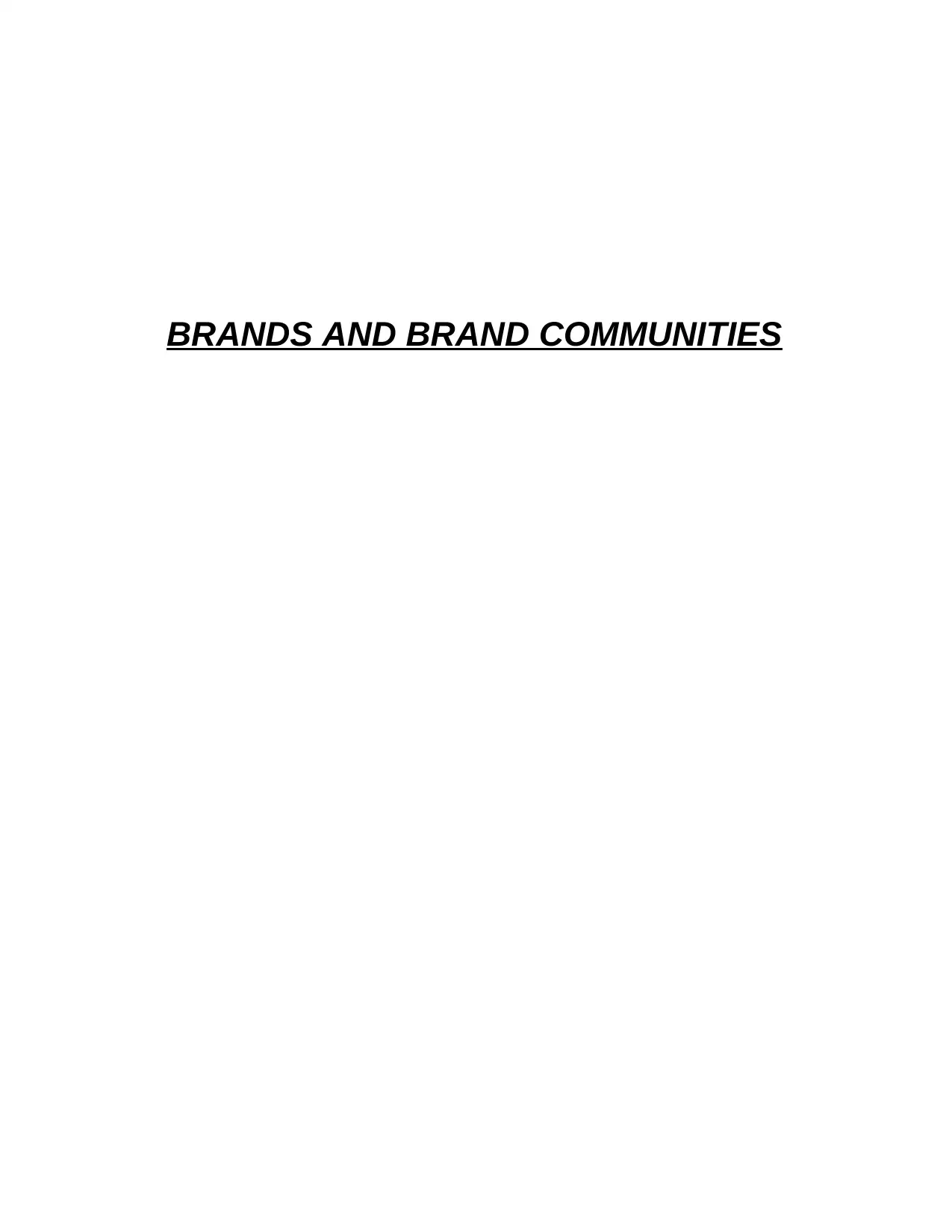
BRANDS AND BRAND COMMUNITIES
Paraphrase This Document
Need a fresh take? Get an instant paraphrase of this document with our AI Paraphraser
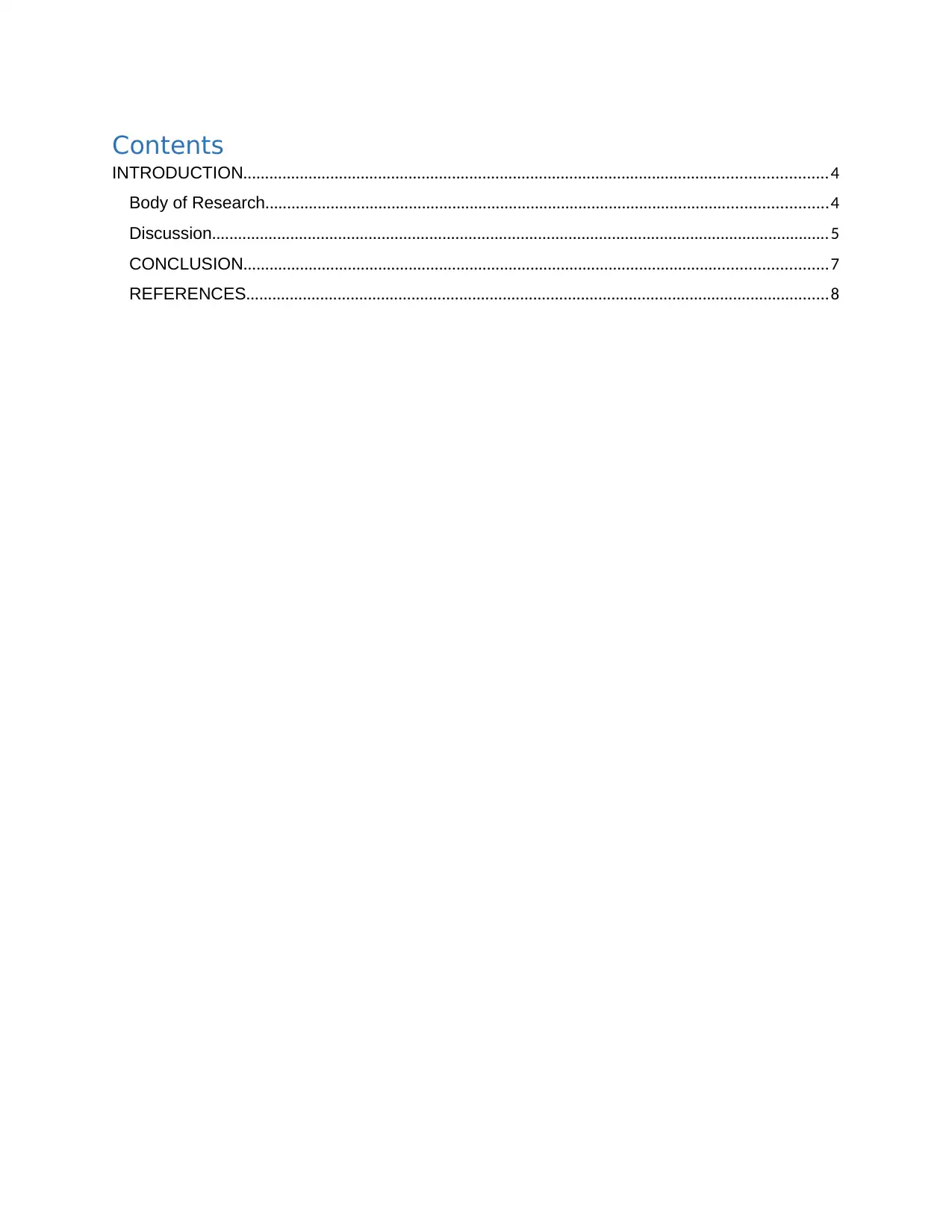
Contents
INTRODUCTION......................................................................................................................................4
Body of Research.................................................................................................................................4
Discussion..............................................................................................................................................5
CONCLUSION......................................................................................................................................7
REFERENCES......................................................................................................................................8
INTRODUCTION......................................................................................................................................4
Body of Research.................................................................................................................................4
Discussion..............................................................................................................................................5
CONCLUSION......................................................................................................................................7
REFERENCES......................................................................................................................................8
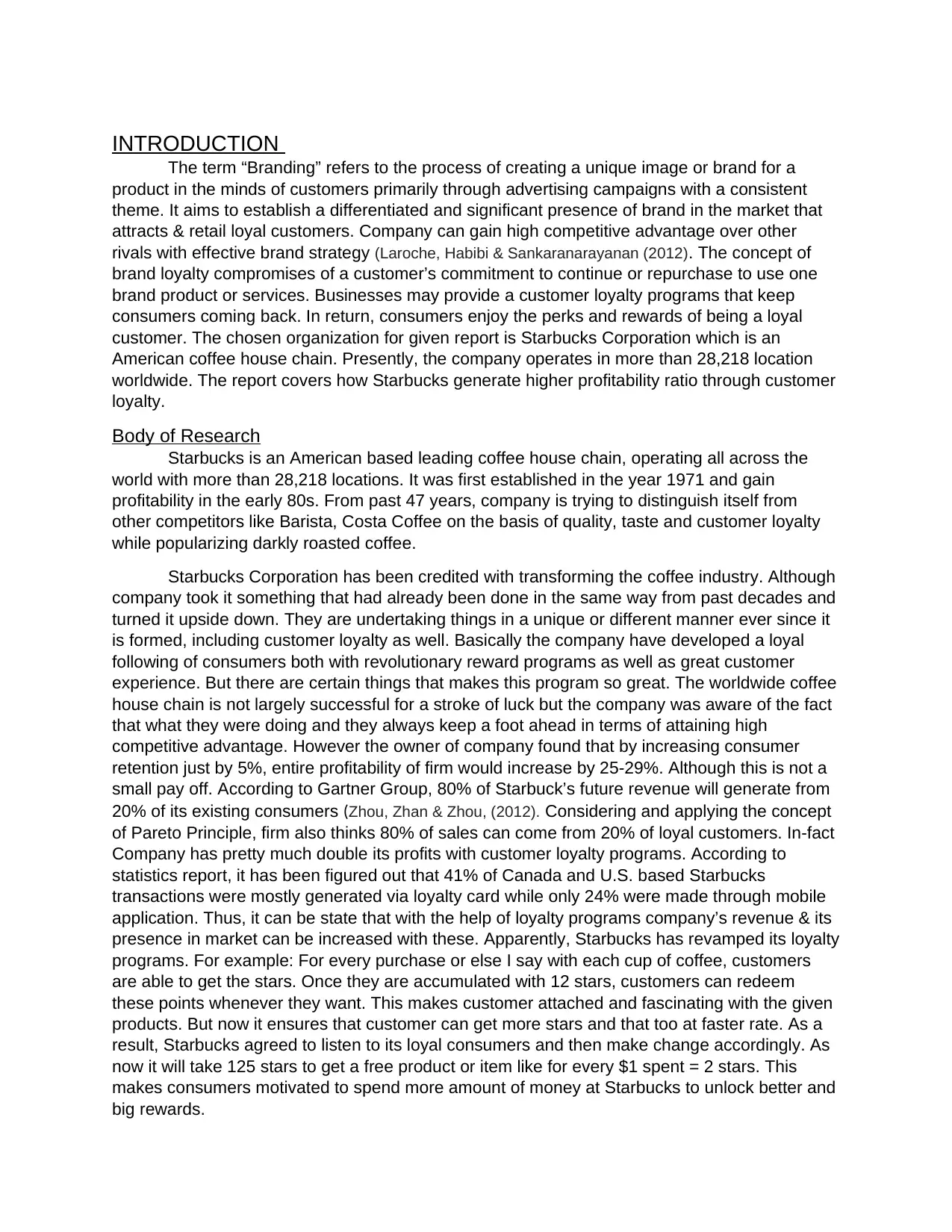
INTRODUCTION
The term “Branding” refers to the process of creating a unique image or brand for a
product in the minds of customers primarily through advertising campaigns with a consistent
theme. It aims to establish a differentiated and significant presence of brand in the market that
attracts & retail loyal customers. Company can gain high competitive advantage over other
rivals with effective brand strategy (Laroche, Habibi & Sankaranarayanan (2012). The concept of
brand loyalty compromises of a customer’s commitment to continue or repurchase to use one
brand product or services. Businesses may provide a customer loyalty programs that keep
consumers coming back. In return, consumers enjoy the perks and rewards of being a loyal
customer. The chosen organization for given report is Starbucks Corporation which is an
American coffee house chain. Presently, the company operates in more than 28,218 location
worldwide. The report covers how Starbucks generate higher profitability ratio through customer
loyalty.
Body of Research
Starbucks is an American based leading coffee house chain, operating all across the
world with more than 28,218 locations. It was first established in the year 1971 and gain
profitability in the early 80s. From past 47 years, company is trying to distinguish itself from
other competitors like Barista, Costa Coffee on the basis of quality, taste and customer loyalty
while popularizing darkly roasted coffee.
Starbucks Corporation has been credited with transforming the coffee industry. Although
company took it something that had already been done in the same way from past decades and
turned it upside down. They are undertaking things in a unique or different manner ever since it
is formed, including customer loyalty as well. Basically the company have developed a loyal
following of consumers both with revolutionary reward programs as well as great customer
experience. But there are certain things that makes this program so great. The worldwide coffee
house chain is not largely successful for a stroke of luck but the company was aware of the fact
that what they were doing and they always keep a foot ahead in terms of attaining high
competitive advantage. However the owner of company found that by increasing consumer
retention just by 5%, entire profitability of firm would increase by 25-29%. Although this is not a
small pay off. According to Gartner Group, 80% of Starbuck’s future revenue will generate from
20% of its existing consumers (Zhou, Zhan & Zhou, (2012). Considering and applying the concept
of Pareto Principle, firm also thinks 80% of sales can come from 20% of loyal customers. In-fact
Company has pretty much double its profits with customer loyalty programs. According to
statistics report, it has been figured out that 41% of Canada and U.S. based Starbucks
transactions were mostly generated via loyalty card while only 24% were made through mobile
application. Thus, it can be state that with the help of loyalty programs company’s revenue & its
presence in market can be increased with these. Apparently, Starbucks has revamped its loyalty
programs. For example: For every purchase or else I say with each cup of coffee, customers
are able to get the stars. Once they are accumulated with 12 stars, customers can redeem
these points whenever they want. This makes customer attached and fascinating with the given
products. But now it ensures that customer can get more stars and that too at faster rate. As a
result, Starbucks agreed to listen to its loyal consumers and then make change accordingly. As
now it will take 125 stars to get a free product or item like for every $1 spent = 2 stars. This
makes consumers motivated to spend more amount of money at Starbucks to unlock better and
big rewards.
The term “Branding” refers to the process of creating a unique image or brand for a
product in the minds of customers primarily through advertising campaigns with a consistent
theme. It aims to establish a differentiated and significant presence of brand in the market that
attracts & retail loyal customers. Company can gain high competitive advantage over other
rivals with effective brand strategy (Laroche, Habibi & Sankaranarayanan (2012). The concept of
brand loyalty compromises of a customer’s commitment to continue or repurchase to use one
brand product or services. Businesses may provide a customer loyalty programs that keep
consumers coming back. In return, consumers enjoy the perks and rewards of being a loyal
customer. The chosen organization for given report is Starbucks Corporation which is an
American coffee house chain. Presently, the company operates in more than 28,218 location
worldwide. The report covers how Starbucks generate higher profitability ratio through customer
loyalty.
Body of Research
Starbucks is an American based leading coffee house chain, operating all across the
world with more than 28,218 locations. It was first established in the year 1971 and gain
profitability in the early 80s. From past 47 years, company is trying to distinguish itself from
other competitors like Barista, Costa Coffee on the basis of quality, taste and customer loyalty
while popularizing darkly roasted coffee.
Starbucks Corporation has been credited with transforming the coffee industry. Although
company took it something that had already been done in the same way from past decades and
turned it upside down. They are undertaking things in a unique or different manner ever since it
is formed, including customer loyalty as well. Basically the company have developed a loyal
following of consumers both with revolutionary reward programs as well as great customer
experience. But there are certain things that makes this program so great. The worldwide coffee
house chain is not largely successful for a stroke of luck but the company was aware of the fact
that what they were doing and they always keep a foot ahead in terms of attaining high
competitive advantage. However the owner of company found that by increasing consumer
retention just by 5%, entire profitability of firm would increase by 25-29%. Although this is not a
small pay off. According to Gartner Group, 80% of Starbuck’s future revenue will generate from
20% of its existing consumers (Zhou, Zhan & Zhou, (2012). Considering and applying the concept
of Pareto Principle, firm also thinks 80% of sales can come from 20% of loyal customers. In-fact
Company has pretty much double its profits with customer loyalty programs. According to
statistics report, it has been figured out that 41% of Canada and U.S. based Starbucks
transactions were mostly generated via loyalty card while only 24% were made through mobile
application. Thus, it can be state that with the help of loyalty programs company’s revenue & its
presence in market can be increased with these. Apparently, Starbucks has revamped its loyalty
programs. For example: For every purchase or else I say with each cup of coffee, customers
are able to get the stars. Once they are accumulated with 12 stars, customers can redeem
these points whenever they want. This makes customer attached and fascinating with the given
products. But now it ensures that customer can get more stars and that too at faster rate. As a
result, Starbucks agreed to listen to its loyal consumers and then make change accordingly. As
now it will take 125 stars to get a free product or item like for every $1 spent = 2 stars. This
makes consumers motivated to spend more amount of money at Starbucks to unlock better and
big rewards.
⊘ This is a preview!⊘
Do you want full access?
Subscribe today to unlock all pages.

Trusted by 1+ million students worldwide
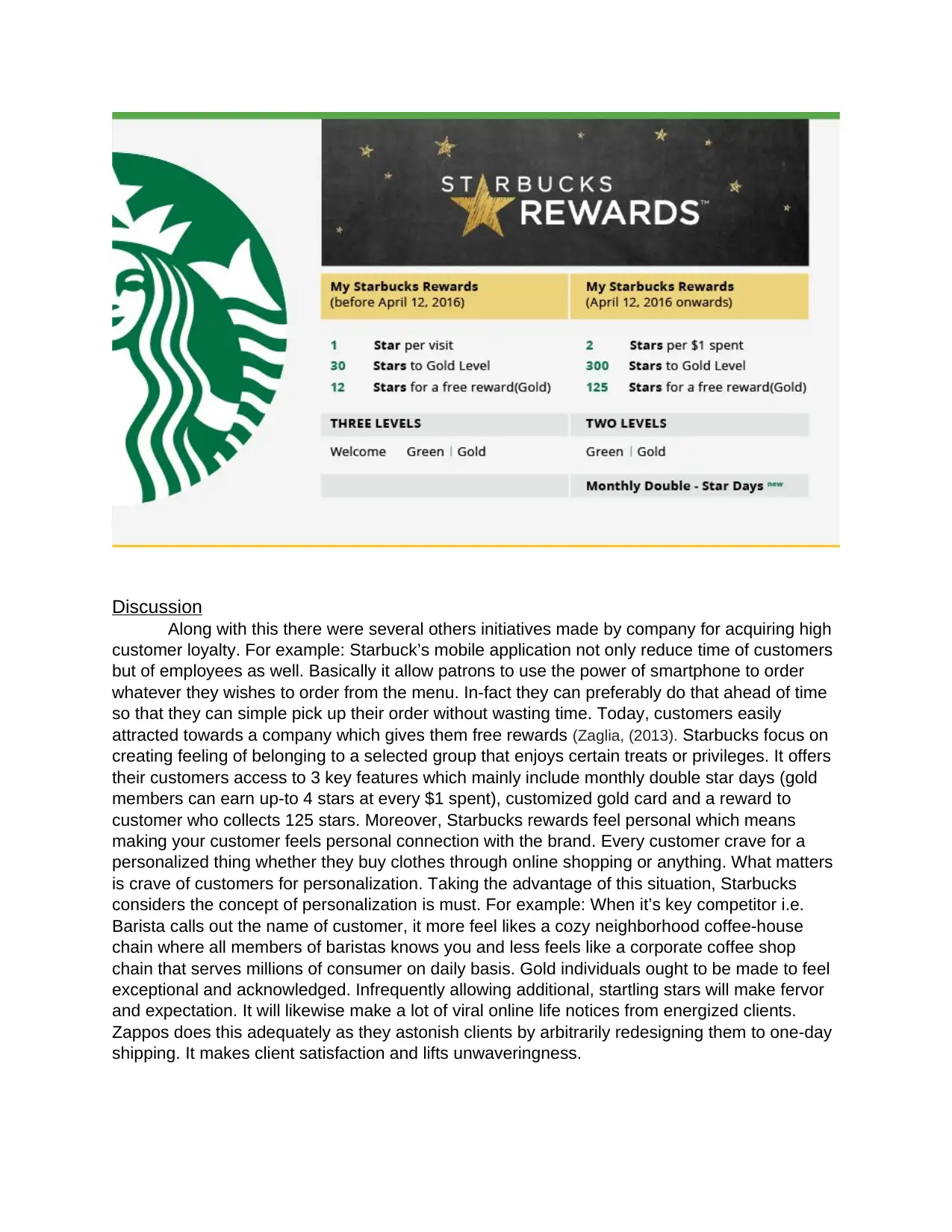
Discussion
Along with this there were several others initiatives made by company for acquiring high
customer loyalty. For example: Starbuck’s mobile application not only reduce time of customers
but of employees as well. Basically it allow patrons to use the power of smartphone to order
whatever they wishes to order from the menu. In-fact they can preferably do that ahead of time
so that they can simple pick up their order without wasting time. Today, customers easily
attracted towards a company which gives them free rewards (Zaglia, (2013). Starbucks focus on
creating feeling of belonging to a selected group that enjoys certain treats or privileges. It offers
their customers access to 3 key features which mainly include monthly double star days (gold
members can earn up-to 4 stars at every $1 spent), customized gold card and a reward to
customer who collects 125 stars. Moreover, Starbucks rewards feel personal which means
making your customer feels personal connection with the brand. Every customer crave for a
personalized thing whether they buy clothes through online shopping or anything. What matters
is crave of customers for personalization. Taking the advantage of this situation, Starbucks
considers the concept of personalization is must. For example: When it’s key competitor i.e.
Barista calls out the name of customer, it more feel likes a cozy neighborhood coffee-house
chain where all members of baristas knows you and less feels like a corporate coffee shop
chain that serves millions of consumer on daily basis. Gold individuals ought to be made to feel
exceptional and acknowledged. Infrequently allowing additional, startling stars will make fervor
and expectation. It will likewise make a lot of viral online life notices from energized clients.
Zappos does this adequately as they astonish clients by arbitrarily redesigning them to one-day
shipping. It makes client satisfaction and lifts unwaveringness.
Along with this there were several others initiatives made by company for acquiring high
customer loyalty. For example: Starbuck’s mobile application not only reduce time of customers
but of employees as well. Basically it allow patrons to use the power of smartphone to order
whatever they wishes to order from the menu. In-fact they can preferably do that ahead of time
so that they can simple pick up their order without wasting time. Today, customers easily
attracted towards a company which gives them free rewards (Zaglia, (2013). Starbucks focus on
creating feeling of belonging to a selected group that enjoys certain treats or privileges. It offers
their customers access to 3 key features which mainly include monthly double star days (gold
members can earn up-to 4 stars at every $1 spent), customized gold card and a reward to
customer who collects 125 stars. Moreover, Starbucks rewards feel personal which means
making your customer feels personal connection with the brand. Every customer crave for a
personalized thing whether they buy clothes through online shopping or anything. What matters
is crave of customers for personalization. Taking the advantage of this situation, Starbucks
considers the concept of personalization is must. For example: When it’s key competitor i.e.
Barista calls out the name of customer, it more feel likes a cozy neighborhood coffee-house
chain where all members of baristas knows you and less feels like a corporate coffee shop
chain that serves millions of consumer on daily basis. Gold individuals ought to be made to feel
exceptional and acknowledged. Infrequently allowing additional, startling stars will make fervor
and expectation. It will likewise make a lot of viral online life notices from energized clients.
Zappos does this adequately as they astonish clients by arbitrarily redesigning them to one-day
shipping. It makes client satisfaction and lifts unwaveringness.
Paraphrase This Document
Need a fresh take? Get an instant paraphrase of this document with our AI Paraphraser
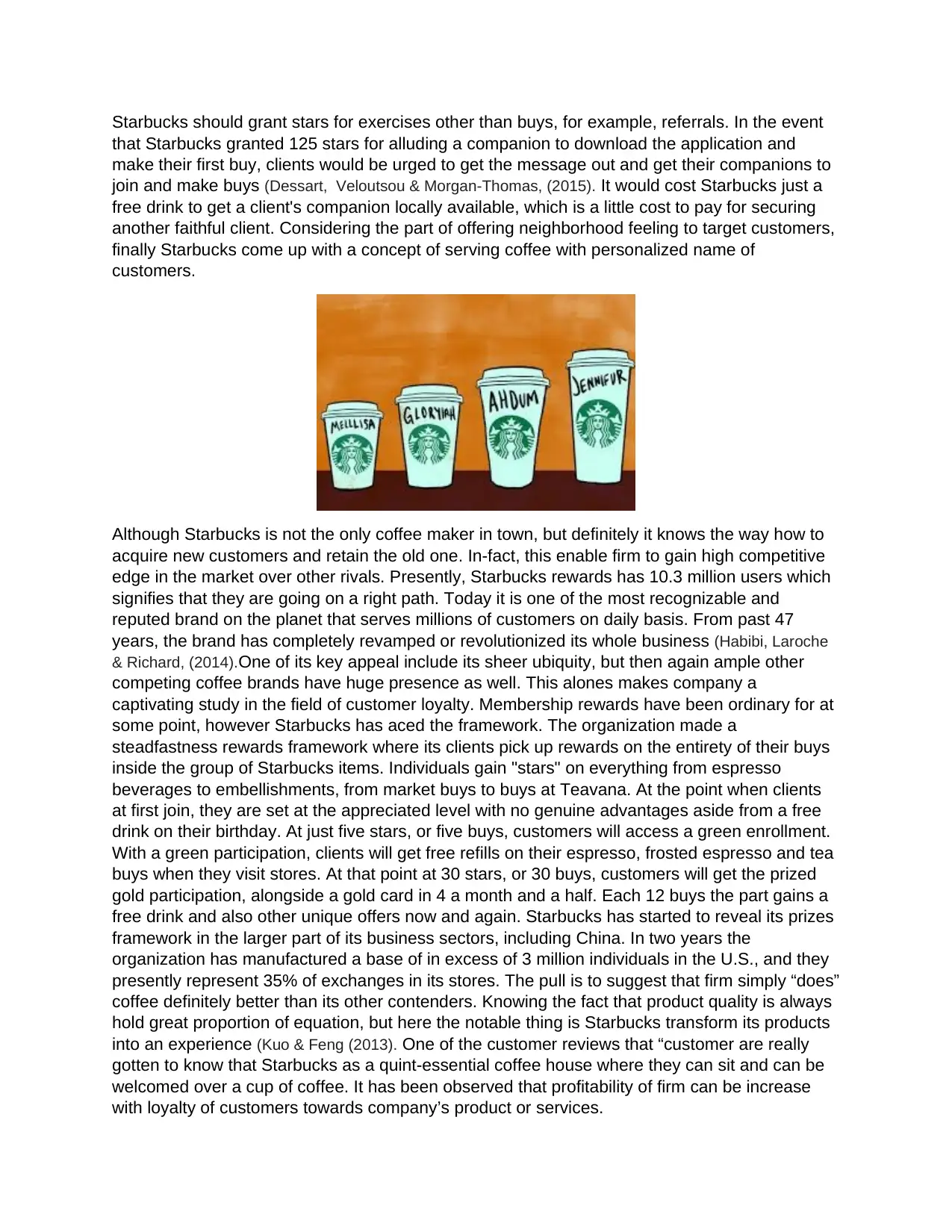
Starbucks should grant stars for exercises other than buys, for example, referrals. In the event
that Starbucks granted 125 stars for alluding a companion to download the application and
make their first buy, clients would be urged to get the message out and get their companions to
join and make buys (Dessart, Veloutsou & Morgan-Thomas, (2015). It would cost Starbucks just a
free drink to get a client's companion locally available, which is a little cost to pay for securing
another faithful client. Considering the part of offering neighborhood feeling to target customers,
finally Starbucks come up with a concept of serving coffee with personalized name of
customers.
Although Starbucks is not the only coffee maker in town, but definitely it knows the way how to
acquire new customers and retain the old one. In-fact, this enable firm to gain high competitive
edge in the market over other rivals. Presently, Starbucks rewards has 10.3 million users which
signifies that they are going on a right path. Today it is one of the most recognizable and
reputed brand on the planet that serves millions of customers on daily basis. From past 47
years, the brand has completely revamped or revolutionized its whole business (Habibi, Laroche
& Richard, (2014).One of its key appeal include its sheer ubiquity, but then again ample other
competing coffee brands have huge presence as well. This alones makes company a
captivating study in the field of customer loyalty. Membership rewards have been ordinary for at
some point, however Starbucks has aced the framework. The organization made a
steadfastness rewards framework where its clients pick up rewards on the entirety of their buys
inside the group of Starbucks items. Individuals gain "stars" on everything from espresso
beverages to embellishments, from market buys to buys at Teavana. At the point when clients
at first join, they are set at the appreciated level with no genuine advantages aside from a free
drink on their birthday. At just five stars, or five buys, customers will access a green enrollment.
With a green participation, clients will get free refills on their espresso, frosted espresso and tea
buys when they visit stores. At that point at 30 stars, or 30 buys, customers will get the prized
gold participation, alongside a gold card in 4 a month and a half. Each 12 buys the part gains a
free drink and also other unique offers now and again. Starbucks has started to reveal its prizes
framework in the larger part of its business sectors, including China. In two years the
organization has manufactured a base of in excess of 3 million individuals in the U.S., and they
presently represent 35% of exchanges in its stores. The pull is to suggest that firm simply “does”
coffee definitely better than its other contenders. Knowing the fact that product quality is always
hold great proportion of equation, but here the notable thing is Starbucks transform its products
into an experience (Kuo & Feng (2013). One of the customer reviews that “customer are really
gotten to know that Starbucks as a quint-essential coffee house where they can sit and can be
welcomed over a cup of coffee. It has been observed that profitability of firm can be increase
with loyalty of customers towards company’s product or services.
that Starbucks granted 125 stars for alluding a companion to download the application and
make their first buy, clients would be urged to get the message out and get their companions to
join and make buys (Dessart, Veloutsou & Morgan-Thomas, (2015). It would cost Starbucks just a
free drink to get a client's companion locally available, which is a little cost to pay for securing
another faithful client. Considering the part of offering neighborhood feeling to target customers,
finally Starbucks come up with a concept of serving coffee with personalized name of
customers.
Although Starbucks is not the only coffee maker in town, but definitely it knows the way how to
acquire new customers and retain the old one. In-fact, this enable firm to gain high competitive
edge in the market over other rivals. Presently, Starbucks rewards has 10.3 million users which
signifies that they are going on a right path. Today it is one of the most recognizable and
reputed brand on the planet that serves millions of customers on daily basis. From past 47
years, the brand has completely revamped or revolutionized its whole business (Habibi, Laroche
& Richard, (2014).One of its key appeal include its sheer ubiquity, but then again ample other
competing coffee brands have huge presence as well. This alones makes company a
captivating study in the field of customer loyalty. Membership rewards have been ordinary for at
some point, however Starbucks has aced the framework. The organization made a
steadfastness rewards framework where its clients pick up rewards on the entirety of their buys
inside the group of Starbucks items. Individuals gain "stars" on everything from espresso
beverages to embellishments, from market buys to buys at Teavana. At the point when clients
at first join, they are set at the appreciated level with no genuine advantages aside from a free
drink on their birthday. At just five stars, or five buys, customers will access a green enrollment.
With a green participation, clients will get free refills on their espresso, frosted espresso and tea
buys when they visit stores. At that point at 30 stars, or 30 buys, customers will get the prized
gold participation, alongside a gold card in 4 a month and a half. Each 12 buys the part gains a
free drink and also other unique offers now and again. Starbucks has started to reveal its prizes
framework in the larger part of its business sectors, including China. In two years the
organization has manufactured a base of in excess of 3 million individuals in the U.S., and they
presently represent 35% of exchanges in its stores. The pull is to suggest that firm simply “does”
coffee definitely better than its other contenders. Knowing the fact that product quality is always
hold great proportion of equation, but here the notable thing is Starbucks transform its products
into an experience (Kuo & Feng (2013). One of the customer reviews that “customer are really
gotten to know that Starbucks as a quint-essential coffee house where they can sit and can be
welcomed over a cup of coffee. It has been observed that profitability of firm can be increase
with loyalty of customers towards company’s product or services.
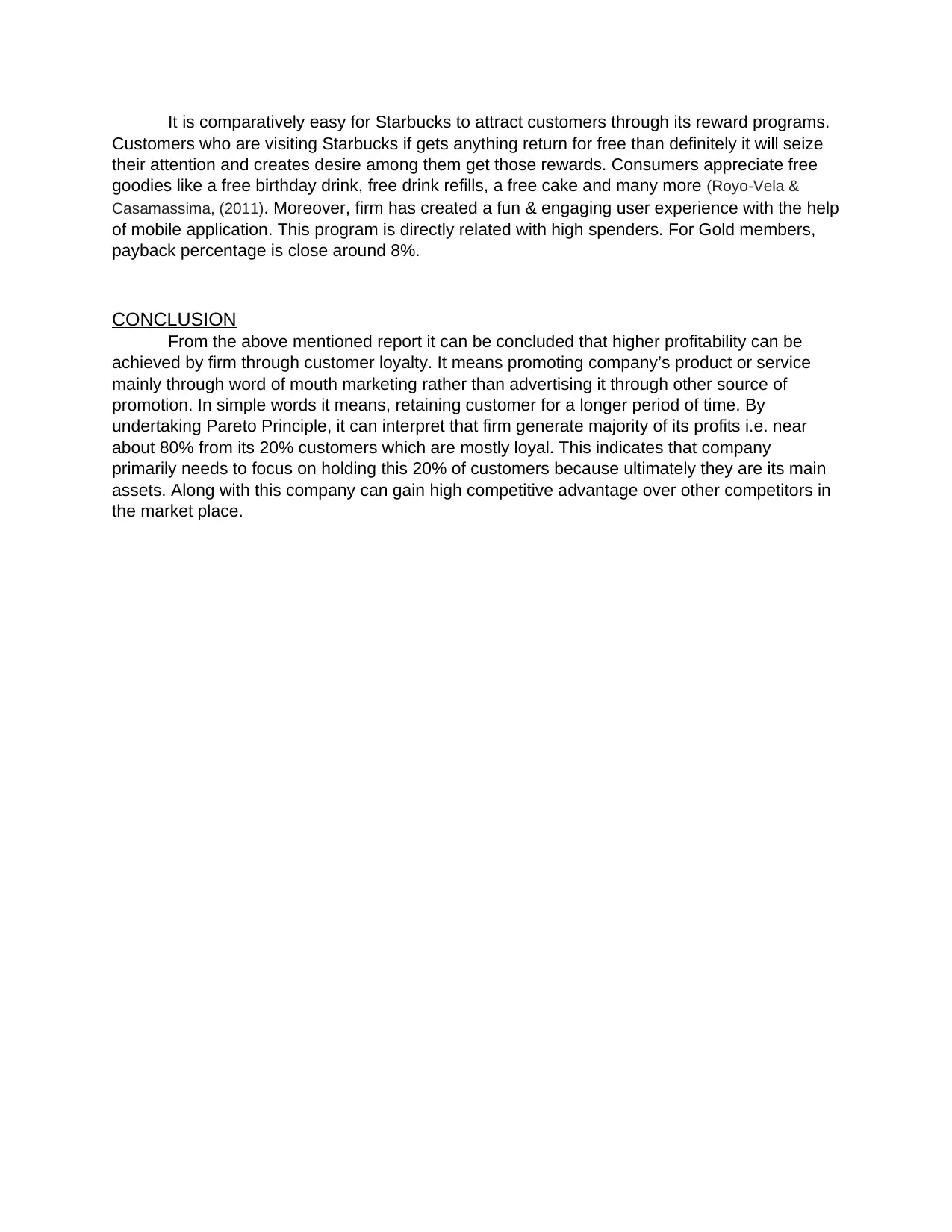
It is comparatively easy for Starbucks to attract customers through its reward programs.
Customers who are visiting Starbucks if gets anything return for free than definitely it will seize
their attention and creates desire among them get those rewards. Consumers appreciate free
goodies like a free birthday drink, free drink refills, a free cake and many more (Royo-Vela &
Casamassima, (2011). Moreover, firm has created a fun & engaging user experience with the help
of mobile application. This program is directly related with high spenders. For Gold members,
payback percentage is close around 8%.
CONCLUSION
From the above mentioned report it can be concluded that higher profitability can be
achieved by firm through customer loyalty. It means promoting company’s product or service
mainly through word of mouth marketing rather than advertising it through other source of
promotion. In simple words it means, retaining customer for a longer period of time. By
undertaking Pareto Principle, it can interpret that firm generate majority of its profits i.e. near
about 80% from its 20% customers which are mostly loyal. This indicates that company
primarily needs to focus on holding this 20% of customers because ultimately they are its main
assets. Along with this company can gain high competitive advantage over other competitors in
the market place.
Customers who are visiting Starbucks if gets anything return for free than definitely it will seize
their attention and creates desire among them get those rewards. Consumers appreciate free
goodies like a free birthday drink, free drink refills, a free cake and many more (Royo-Vela &
Casamassima, (2011). Moreover, firm has created a fun & engaging user experience with the help
of mobile application. This program is directly related with high spenders. For Gold members,
payback percentage is close around 8%.
CONCLUSION
From the above mentioned report it can be concluded that higher profitability can be
achieved by firm through customer loyalty. It means promoting company’s product or service
mainly through word of mouth marketing rather than advertising it through other source of
promotion. In simple words it means, retaining customer for a longer period of time. By
undertaking Pareto Principle, it can interpret that firm generate majority of its profits i.e. near
about 80% from its 20% customers which are mostly loyal. This indicates that company
primarily needs to focus on holding this 20% of customers because ultimately they are its main
assets. Along with this company can gain high competitive advantage over other competitors in
the market place.
⊘ This is a preview!⊘
Do you want full access?
Subscribe today to unlock all pages.

Trusted by 1+ million students worldwide
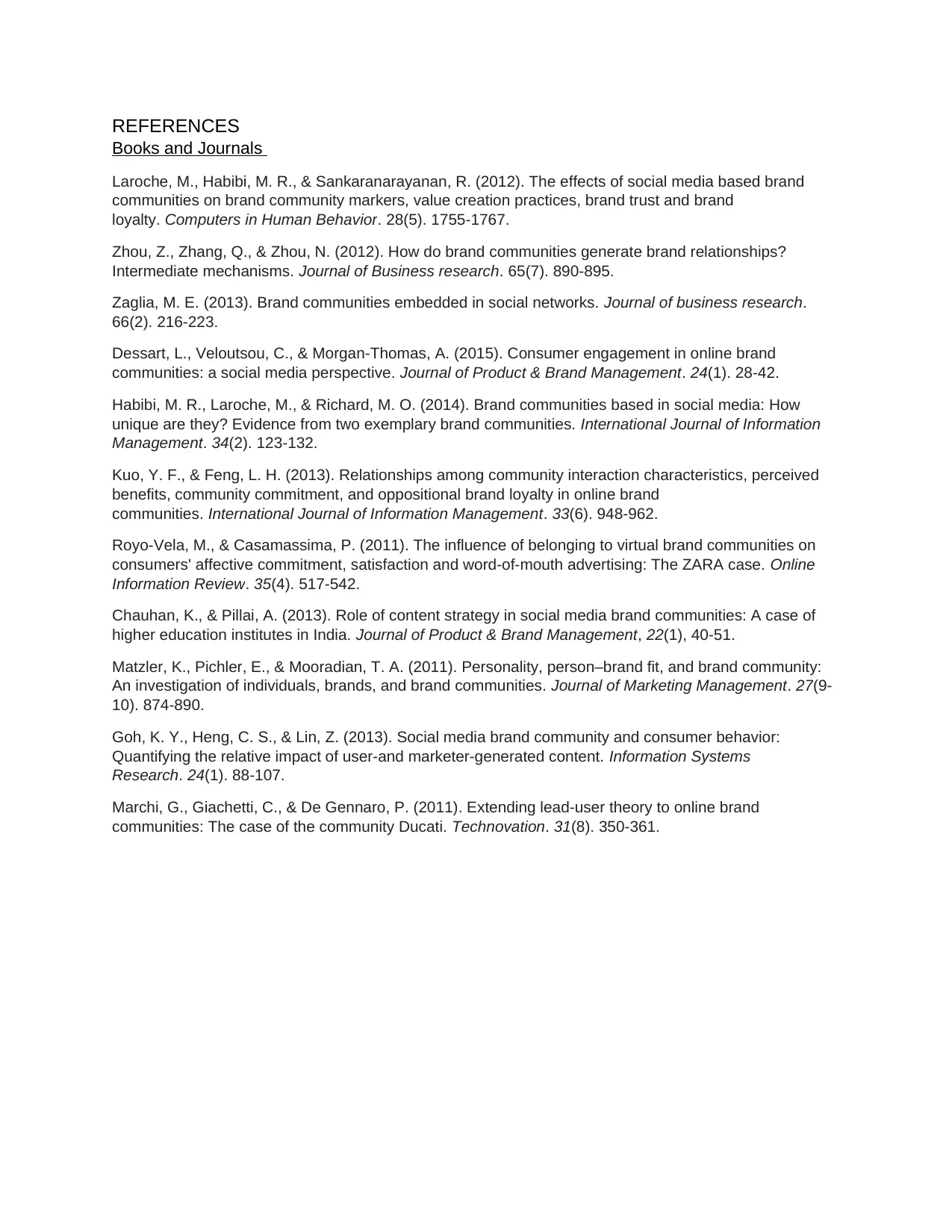
REFERENCES
Books and Journals
Laroche, M., Habibi, M. R., & Sankaranarayanan, R. (2012). The effects of social media based brand
communities on brand community markers, value creation practices, brand trust and brand
loyalty. Computers in Human Behavior. 28(5). 1755-1767.
Zhou, Z., Zhang, Q., & Zhou, N. (2012). How do brand communities generate brand relationships?
Intermediate mechanisms. Journal of Business research. 65(7). 890-895.
Zaglia, M. E. (2013). Brand communities embedded in social networks. Journal of business research.
66(2). 216-223.
Dessart, L., Veloutsou, C., & Morgan-Thomas, A. (2015). Consumer engagement in online brand
communities: a social media perspective. Journal of Product & Brand Management. 24(1). 28-42.
Habibi, M. R., Laroche, M., & Richard, M. O. (2014). Brand communities based in social media: How
unique are they? Evidence from two exemplary brand communities. International Journal of Information
Management. 34(2). 123-132.
Kuo, Y. F., & Feng, L. H. (2013). Relationships among community interaction characteristics, perceived
benefits, community commitment, and oppositional brand loyalty in online brand
communities. International Journal of Information Management. 33(6). 948-962.
Royo-Vela, M., & Casamassima, P. (2011). The influence of belonging to virtual brand communities on
consumers' affective commitment, satisfaction and word-of-mouth advertising: The ZARA case. Online
Information Review. 35(4). 517-542.
Chauhan, K., & Pillai, A. (2013). Role of content strategy in social media brand communities: A case of
higher education institutes in India. Journal of Product & Brand Management, 22(1), 40-51.
Matzler, K., Pichler, E., & Mooradian, T. A. (2011). Personality, person–brand fit, and brand community:
An investigation of individuals, brands, and brand communities. Journal of Marketing Management. 27(9-
10). 874-890.
Goh, K. Y., Heng, C. S., & Lin, Z. (2013). Social media brand community and consumer behavior:
Quantifying the relative impact of user-and marketer-generated content. Information Systems
Research. 24(1). 88-107.
Marchi, G., Giachetti, C., & De Gennaro, P. (2011). Extending lead-user theory to online brand
communities: The case of the community Ducati. Technovation. 31(8). 350-361.
Books and Journals
Laroche, M., Habibi, M. R., & Sankaranarayanan, R. (2012). The effects of social media based brand
communities on brand community markers, value creation practices, brand trust and brand
loyalty. Computers in Human Behavior. 28(5). 1755-1767.
Zhou, Z., Zhang, Q., & Zhou, N. (2012). How do brand communities generate brand relationships?
Intermediate mechanisms. Journal of Business research. 65(7). 890-895.
Zaglia, M. E. (2013). Brand communities embedded in social networks. Journal of business research.
66(2). 216-223.
Dessart, L., Veloutsou, C., & Morgan-Thomas, A. (2015). Consumer engagement in online brand
communities: a social media perspective. Journal of Product & Brand Management. 24(1). 28-42.
Habibi, M. R., Laroche, M., & Richard, M. O. (2014). Brand communities based in social media: How
unique are they? Evidence from two exemplary brand communities. International Journal of Information
Management. 34(2). 123-132.
Kuo, Y. F., & Feng, L. H. (2013). Relationships among community interaction characteristics, perceived
benefits, community commitment, and oppositional brand loyalty in online brand
communities. International Journal of Information Management. 33(6). 948-962.
Royo-Vela, M., & Casamassima, P. (2011). The influence of belonging to virtual brand communities on
consumers' affective commitment, satisfaction and word-of-mouth advertising: The ZARA case. Online
Information Review. 35(4). 517-542.
Chauhan, K., & Pillai, A. (2013). Role of content strategy in social media brand communities: A case of
higher education institutes in India. Journal of Product & Brand Management, 22(1), 40-51.
Matzler, K., Pichler, E., & Mooradian, T. A. (2011). Personality, person–brand fit, and brand community:
An investigation of individuals, brands, and brand communities. Journal of Marketing Management. 27(9-
10). 874-890.
Goh, K. Y., Heng, C. S., & Lin, Z. (2013). Social media brand community and consumer behavior:
Quantifying the relative impact of user-and marketer-generated content. Information Systems
Research. 24(1). 88-107.
Marchi, G., Giachetti, C., & De Gennaro, P. (2011). Extending lead-user theory to online brand
communities: The case of the community Ducati. Technovation. 31(8). 350-361.
1 out of 7
Related Documents
Your All-in-One AI-Powered Toolkit for Academic Success.
+13062052269
info@desklib.com
Available 24*7 on WhatsApp / Email
![[object Object]](/_next/static/media/star-bottom.7253800d.svg)
Unlock your academic potential
Copyright © 2020–2025 A2Z Services. All Rights Reserved. Developed and managed by ZUCOL.





